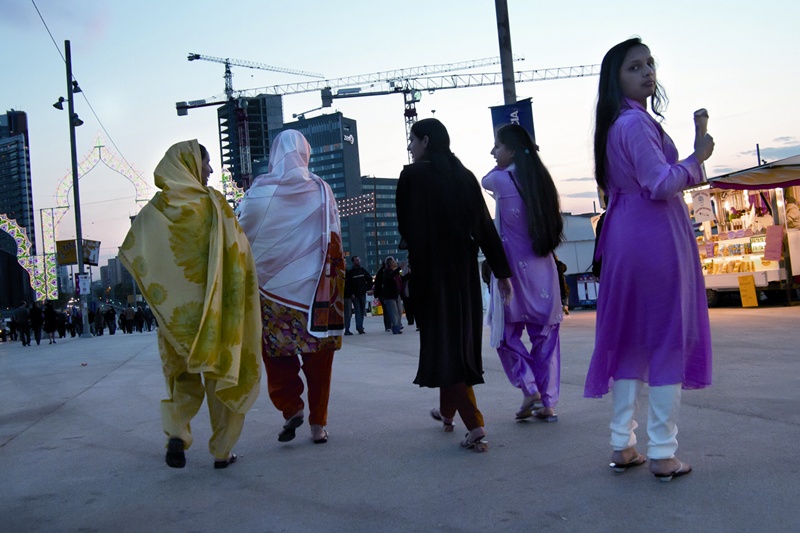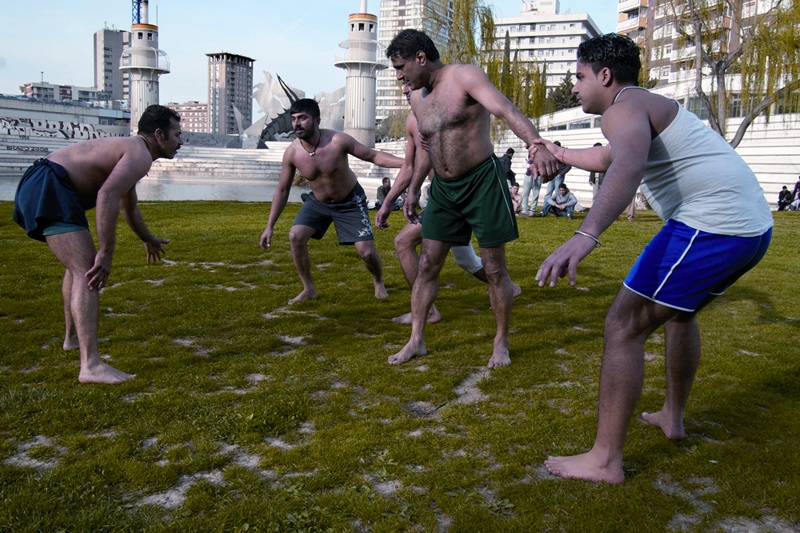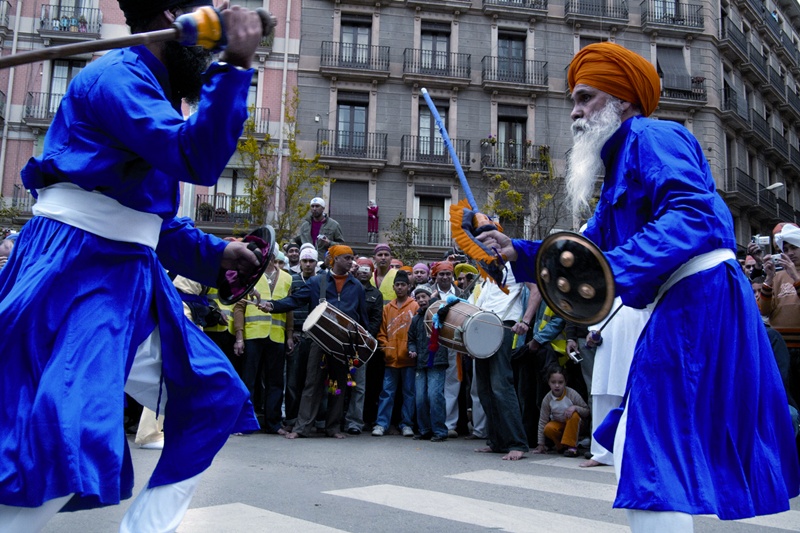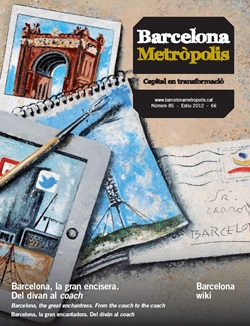
© Eva Parey
A family originally from the Punjab, now settled in Badalona, walk through the Forum, April 2009
Now and again, someone in India asks me if Barcelona is the capital of Spain. As I don’t want to disappoint them, I always say yes, and they put on that “I knew it” face. The urge to be a capital has been regularly raising its head since the Middle Ages. Another question is whether contemporary Barcelona knows what it wants to be capital of. But some Indians seem sure. When you live in New Delhi, it becomes clear that Barcelona is not in the same league and doesn’t need to be. In Barcelona there is no central authority with organisations that are beneficiaries (or parasites) of its body heat, like embassies or, on a larger scale, multinationals living off public contracts, or lobbyists, correspondents, etc.
One of the myths about capitals is that who you know counts for more than what you know or what you do. For that and plenty of other reasons, many prefer New York to Washington, Shanghai to Beijing or, for that matter, Mumbai to New Delhi and Barcelona to Madrid. Cities that are self-made have a spirit of their own. For them, dynamism is not an option; it is a necessity, usually accompanied by other strengths such as innovation, openness, agility and joie de vivre. In other words, everything that makes a terrible bedfellow for bureaucracy, hierarchy and form-filling.
However, dynamism withers if it is not nurtured and if it cannot translate into power or political influence. Barcelona cannot afford to let the necessary debate on identity smother other urgent debates that shake advanced capitalist economies awake. The Catalan capital cannot just stand there gaping; it’s neither in a cul de sac nor at a crossroads, nor does it have the economic clout or population size to make it an indisputable point on the world map.

© Eva Parey
Group of young people from the Indo-Pakistan community play kabadi, the signature sport of the Punjab, in Espanya Industrial Park (March 2008).
So Barcelona is not Delhi, but nor is it Mumbai. From a qualitative, if not a quantitative perspective, it is even superior to Mumbai and many other emerging cities in most regards. And it can continue to be so, but it must choose its challenges more carefully. This need was already felt with the Universal Forum of Cultures of 2004, an unsatisfactory offshoot of the great events of 1888, 1929 and 1992 (two expos and the Olympics). A Barcelona with empty coffers can no longer resort to the same formula to reinvent itself.
Nevertheless, Barcelona has many things in its favour. Compared to an Indian city of its size (or ten times larger), the most obvious one is the political strength and budgetary powers of the municipal authorities. It is of no surprise to Indians, who live in a federal state, that a regional level of authority sits between the city and the nation state. To a citizen of India (or Pakistan) the differences between Catalans and Castilians are not that surprising; they are perfectly acceptable. Likewise, this citizen would easily understand political, educational, health-service, cultural and linguistic autonomy because India is organised in much the same way. Moving from state to state in India usually means moving to a different official language and even a different alphabet.
This hypothetical Indian visitor to our shores – let’s call him Abhishek – would find that life can be very good in Barcelona because of the beauty and personality of this attractive city with its beaches and hills, history and modernity, great climate and even better cuisine, albeit (alas!) not spicy enough; attractive, too, because of perks in the form of public services and transport, public order and cleanliness, and civic, cultural and health facilities. However, there are no real skyscrapers, so your average Indian would look at the Barcelona skyline with some disappointment. In India, buildings are demolished indiscriminately in order to unfailingly build uglier buildings in their place. “Ancient” and “old” are synonyms, clearly inferior to “new” and “modern”. Walls are brought down, but the mental walls of religion and caste remain.

© Eva Parey
The Dance of the Swords at the Harvest Festival, a Sikh celebration staged in the Raval district on 13 April.
As Abhishek strolls around the Eixample, he may notice that Barcelona has an official language that is not Spanish, but this won’t surprise him much: rupee notes are written in sixteen languages and ten alphabets. He’d be disappointed that so few people speak good English. It’s true that Catalan is much stronger in Barcelona than Kannada in Bangalore or Marathi in Mumbai (also official languages). Mumbai is happy to be the capital of Hindi communications and cinema (Bollywood). But New Delhi scrupulously respects the right of Tamils to live their lives in Tamil and of Bengalis to live in Bengali, for example.
Our friend has come to Barcelona because, although he only discovered at the last minute that the capital is a different city where he may not have to stop over if flight connections permit, Spain has never had so much visibility in India as it has in the last five years. If, despite the financial crisis, the Spain brand holds up, the Barcelona brand will continue to bubble up to the surface. Like tens of millions of other Indians, Abhishek has seen the film Zindagi Na Milegi Dobara, last year’s big Bollywood hit, shot in Barcelona, the Empordà coast, Bunyol and Pamplona. Abhishek is delighted that, just like in the cinema, Barcelona is a showcase for the Mediterranean, with an appealing blend of fiesta, culture, shows and cuisine.
When I was living in Lisbon, the first thing that would surprise me on landing in Barcelona was the vitality and the noise. Over the years, that vivacity became more intense, accompanied by a wave of immigration almost always from warmer, more colourful climes with spicier food. Now the statistics are telling us that the trend has been reversed. So Abhishek will notice the diversity of ethnic groups and nationalities, but he won’t be surprised by the lack of real integration, despite the “strange” discourse about the racial mix.
It’s true that, for a couple of years now, coming back to Barcelona has been less and less uplifting, if not to say depressing. Last Christmas, the uncertainty and despondency on the city streets were palpable. We were never “the best city in the world”, but nor are we about to pale into insignificance. Abhishek, who must have the memory of corruption and squandering surrounding the 2010 Commonwealth Games in Delhi still fresh in his mind, would be pleasantly surprised by the urban transformation that took place for the Olympic Games and 2004 Universal Forum of Cultures, and how it was integrated into the city.
In mid-2008 it felt like everyone was walking on tiptoes. And it’s hard to cover much ground that way. When Zapatero said that we had overtaken Italy and would soon pass France, it looked like he was clamouring for the current internal devaluation. It now seems that many educated young people who could stand on their own two feet have no choice but to pack up and leave for Germany or Canada. The Barcelona that turned its back on the sea for so long has now become an extension of the beach all the way up to the Gran Via, a place that destroys qualified jobs and creates McJobs for anyone who wants. At first glance, it appears that we are now Brazil (getting poorer but with football, beaches and the best fiestas), and that Brazil is what we once were. But don’t worry; Brazil and Argentina are also starting to tiptoe. And the Indian government has its fingers crossed.
However, there is a fundamental and paradoxical difference between the Indian visitor and his Barcelona hosts. Some things are a matter of opinion; others are not. For example, life expectancy for a Catalan woman is 15 years more than for an Indian woman and she gets very many more years of schooling. But for the Indian, the future holds promise and he looks to it with the enthusiasm of one who is in no doubt that it will be better than the present. The citizen of Barcelona no longer does this.
Last summer in Mumbai, I was lucky enough to follow the Catalan human pyramid group, the Castellers de Vilafranca, with their local version, the govindas. It was fascinating to see how the same phenomenon had evolved independently in two very distant societies and sets of values. The govindas were all boys, poor but impassioned… their pyramids went up as fast as they fell down.
The Vilafranca group still manage to build their pyramids one-storey higher than the Indians, but what is really interesting is how they represented a completely different and, in my view, enviable society: a community of men and women, boys and girls, lads and lasses of different backgrounds, jobs and social classes – democracy in motion. The mayor was just one of the group, doing his bit, letting his neighbours literally walk all over him! In this India that is fragmented by so many different prejudices, that is literally political fiction. If our cohesiveness can stand up to the battering of this crisis and become stronger for it, Barcelona will continue upwards for a long time to come. It is the Indian model that must follow ours more closely. If instead we let our model be swallowed up by the depths of India, we will lose everything.




Felicitats per l’article!